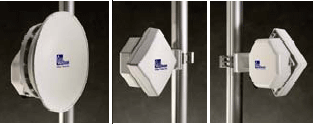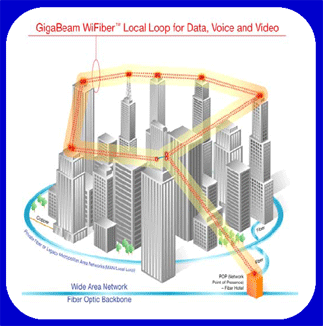 WiFiber
Wireless Fiber WiFiber
Wireless Fiber
- Best Cost/Performance
- Lowest Cost of Ownership
- Reliability
- Smallest Footprint
- Easiest Installation
COMPANY BACKGROUND
Founded in January 2004 by two widely acknowledged experts in the
field of millimeter wave wireless technology, GigaBeam, based in
Herndon, Virginia, is fast earning distinction as the Company with the
solution to overcome the numerous impediments to pervasive high speed
broadband delivery.
GigaBeam’s WiFiber® technology enables point-to-point wireless
communications using very high radio frequencies (at 71-76 and 81-86
GHz) for multigigabit- per-second transmission of data, voice and
video, enabling implementation of “Triple Play” services including
HDTV.
Driven by the efforts of GigaBeam’s co-founders, on October 16, 2003,
the U.S. Federal Communications Commission (FCC) authorized commercial
licensing rules for this very high frequency spectrum, creating the
opportunity to bring WiFiber to market. These new ultra-high frequency
bands are the only ones that allow wireless fiber-equivalent speeds
with reliability similar to terrestrial fiber. WiFiber, by providing
last mile access and backhaul, is complementary to both WiFi and
WiMax. Users pay a nominal one-time fee for a point-to-point license
that has a 10-year term. Licensing approval typically takes less than
24-hours.

APPLICATIONS
Fiber (Backbone) POP Access
Redundant Access — Network Diversity
Enterprise Campus Connectivity
Local Area Network (LAN) Extension
Local Loop
Metropolitan Area Network (MAN)
Wide Area Network (WAN) Access
Central Office Bypass
Storage Access (SAN and NAS)
Wireless Backhaul (3G, 4G WiMax and Wi-Fi)
High Definition Video
OUR VISION
WiFiber® is an entirely new concept in point-to-point wireless
technology. Our vision is to enable communications capacity delivery
faster and less costly than previously possible.
With the addition of WiFiber to the nation’s information backbone,
many customers will now have access to video/data/voice at prices once
unimaginable. According to Cisco Systems’ exparte filing with the FCC
(May 2003), less than 5% of the 750,000 commercial buildings in the
United States have current access to fiber. The result has been a
connectivity divide between the United States and numerous other
countries. GigaBeam believes that widespread availability of high
speed communications bandwidth will improve economic productivity,
help close the digital divide, and improve the overall quality of
life.
WHAT OUR CUSTOMERS ARE SAYING
“...GigaBeam’s WiFiber will enable us to address the rapidly
growing high speed network demands of Dartmouth’s advanced information
environment...Dartmouth, which maintains one of the most advanced
university IT infrastructures in the country, has chosen GigaBeam’s
innovative WiFiber solution.”
-Robert Johnson, Dir. of Telecom and Network Services, Dartmouth
College
“...It was clear that GigaBeam's WiFiber solution will provide
Boston University with the performance and availability our
organization requires. By providing access diversity, GigaBeam's
technology will protect the Medical School against construction
mishaps and other disasters...it will also provide ten times the speed
of our current fiber connection...effectively resulting in the
terrestrial fiber becoming our back-up link.”
-Paul Sheehan, Director of Networks, Boston University Medical Center
MARKETS
- Government: Federal, State, and
Local
- Enterprise: Fortune 1000
- Next Generation Service Providers:
CLECs, ISPs, and Cable Companies
- Large Carriers: ILECs, IXCs, and
PTTs
- Wireless Service Providers
- International Enterprises and
Service Providers
- Education
WHITE PAPER
White
Paper on WiMAX Backhaul at 70/80ghz
WiMAX promises to bring high-speed data
connectivity to a wide coverage area, opening up ubiquitous internet
access without costly investment in wire-line infrastructure. A lot of
consideration has been given to the access portion of WiMAX
networks: the fixed and mobile specifications 802.16-2004 and
802.16e-2005 respectively have both been ratified; the first WiMAX
certified fixed products are available and mobile products are
expected in late 2006. The WiMAX Forum, an industry group of nearly
400 member companies, estimates that there are already more than 150
announced commercial trials and deployments of fixed WiMAX networks. |